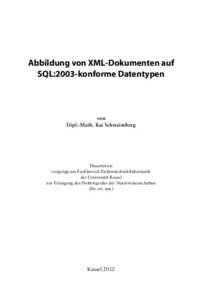| dc.date.accessioned | 2012-08-10T07:02:45Z | |
| dc.date.available | 2012-08-10T07:02:45Z | |
| dc.date.issued | 2012-08-10 | |
| dc.identifier.uri | urn:nbn:de:hebis:34-2012081041594 | |
| dc.identifier.uri | http://hdl.handle.net/123456789/2012081041594 | |
| dc.language.iso | ger | |
| dc.rights | Urheberrechtlich geschützt | |
| dc.rights.uri | https://rightsstatements.org/page/InC/1.0/ | |
| dc.subject.ddc | 004 | |
| dc.title | Abbildung von XML-Dokumenten auf SQL:2003-konforme Datentypen | ger |
| dc.type | Dissertation | |
| dcterms.abstract | Die Auszeichnungssprache XML dient zur Annotation von Dokumenten und hat sich als Standard-Datenaustauschformat durchgesetzt. Dabei entsteht der Bedarf, XML-Dokumente nicht nur als reine Textdateien zu speichern und zu transferieren, sondern sie auch persistent in besser strukturierter Form abzulegen. Dies kann unter anderem in speziellen XML- oder relationalen Datenbanken geschehen. Relationale Datenbanken setzen dazu bisher auf zwei grundsätzlich verschiedene Verfahren: Die XML-Dokumente werden entweder unverändert als binäre oder Zeichenkettenobjekte gespeichert oder aber aufgespalten, sodass sie in herkömmlichen relationalen Tabellen normalisiert abgelegt werden können (so genanntes „Flachklopfen“ oder „Schreddern“ der hierarchischen Struktur).
Diese Dissertation verfolgt einen neuen Ansatz, der einen Mittelweg zwischen den bisherigen Lösungen darstellt und die Möglichkeiten des weiterentwickelten SQL-Standards aufgreift. SQL:2003 definiert komplexe Struktur- und Kollektionstypen (Tupel, Felder, Listen, Mengen, Multimengen), die es erlauben, XML-Dokumente derart auf relationale Strukturen abzubilden, dass der hierarchische Aufbau erhalten bleibt. Dies bietet zwei Vorteile: Einerseits stehen bewährte Technologien, die aus dem Bereich der relationalen Datenbanken stammen, uneingeschränkt zur Verfügung. Andererseits lässt sich mit Hilfe der SQL:2003-Typen die inhärente Baumstruktur der XML-Dokumente bewahren, sodass es nicht erforderlich ist, diese im Bedarfsfall durch aufwendige Joins aus den meist normalisierten und auf mehrere Tabellen verteilten Tupeln zusammenzusetzen.
In dieser Arbeit werden zunächst grundsätzliche Fragen zu passenden, effizienten Abbildungsformen von XML-Dokumenten auf SQL:2003-konforme Datentypen geklärt. Darauf aufbauend wird ein geeignetes, umkehrbares Umsetzungsverfahren entwickelt, das im Rahmen einer prototypischen Applikation implementiert und analysiert wird. Beim Entwurf des Abbildungsverfahrens wird besonderer Wert auf die Einsatzmöglichkeit in Verbindung mit einem existierenden, ausgereiften relationalen Datenbankmanagementsystem (DBMS) gelegt. Da die Unterstützung von SQL:2003 in den kommerziellen DBMS bisher nur unvollständig ist, muss untersucht werden, inwieweit sich die einzelnen Systeme für das zu implementierende Abbildungsverfahren eignen. Dabei stellt sich heraus, dass unter den betrachteten Produkten das DBMS IBM Informix die beste Unterstützung für komplexe Struktur- und Kollektionstypen bietet.
Um die Leistungsfähigkeit des Verfahrens besser beurteilen zu können, nimmt die Arbeit Untersuchungen des nötigen Zeitbedarfs und des erforderlichen Arbeits- und Datenbankspeichers der Implementierung vor und bewertet die Ergebnisse. | ger |
| dcterms.abstract | The markup language XML is used for annotating documents and has established itself as standard data exchange format. Consequently, there is a need to store and transfer these documents not only as pure text files, but also better structured in persistent storage. This can be achieved by means of particular XML or relational database systems. Relational databases handle this up to now in two different ways: The XML documents are either stored unchanged as binary or string objects, or they are broken up and stored normalized in conventional relational tables (so-called “flattening” or “shredding” of the hierarchical structure).
This dissertation takes a new approach which kind of lies in the middle of the previous solutions. It takes advantage of the opportunities of the advanced features in the SQL standard. SQL:2003 defines complex structure and collection types (tuples, arrays, lists, sets, multisets). They allow a mapping of XML documents to relational schemes which preserves the hierarchical structure. This offers two advantages: on one side, proven technologies that originate from the area of relational databases are available without any restrictions. On the other side, using the SQL:2003 types preserves the inherent tree structure of XML documents, so in case of having to rebuild the documents, expensive joins over the tuples from normalized and distributed tables can be avoided.
The thesis starts with basic questions concerning appropriate and efficient forms of mapping XML documents to SQL:2003-compliant data types. Based on this, a suitable, reversible conversion method is developed which is subsequently implemented in a prototype application and then analyzed. The design of the mapping aims at a later use with an existing, mature relational database management system (DBMS). However, support of SQL:2003 in the commercial DBMS world is still incomplete. Thus the thesis investigates to what extent the various systems are suited for the implementation of the mapping process. It turns out that under the products considered, IBM Informix offers the best support for complex structure and collection types.
To better assess the performance of the mapping process, the observed running time and the required in-memory and database storage of the implementation are measured and the results are evaluated. | eng |
| dcterms.accessRights | open access | |
| dcterms.creator | Schweinsberg, Kai | |
| dc.contributor.corporatename | Kassel, Univ., Fachbereich Elektrotechnik/Informatik | |
| dc.contributor.referee | Wegner, Lutz (Prof. Dr.) | |
| dc.contributor.referee | Küspert, Klaus (Prof. Dr.) | |
| dc.subject.ccs | H.2.4 | |
| dc.subject.ccs | I.7.2 | |
| dc.subject.ccs | H.3.4 | |
| dc.subject.swd | Datenbanksystem | ger |
| dc.subject.swd | SQL | ger |
| dc.subject.swd | XML | ger |
| dc.date.examination | 2012-06-15 | |

